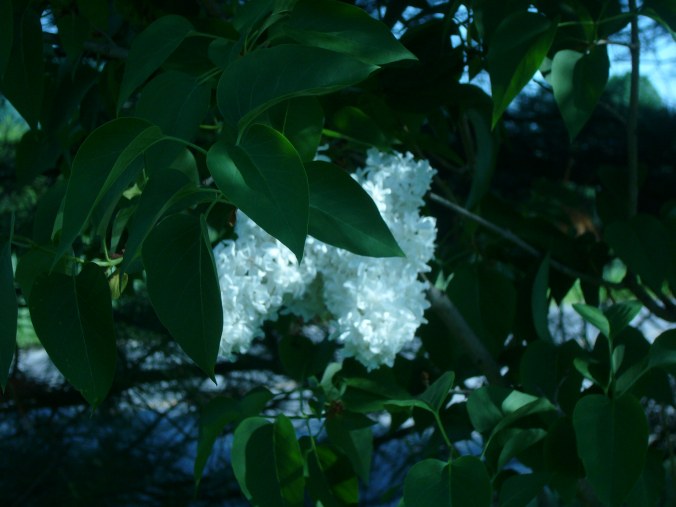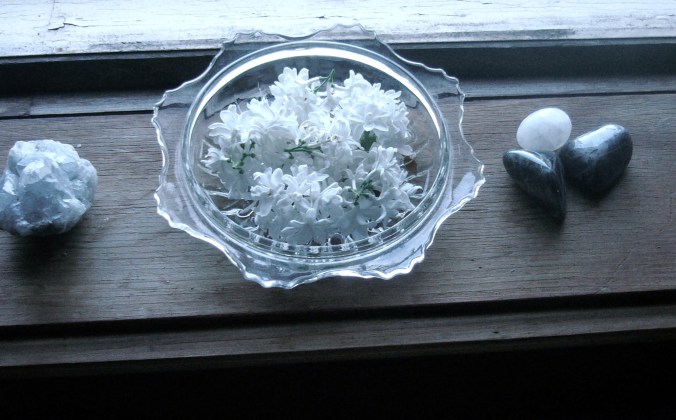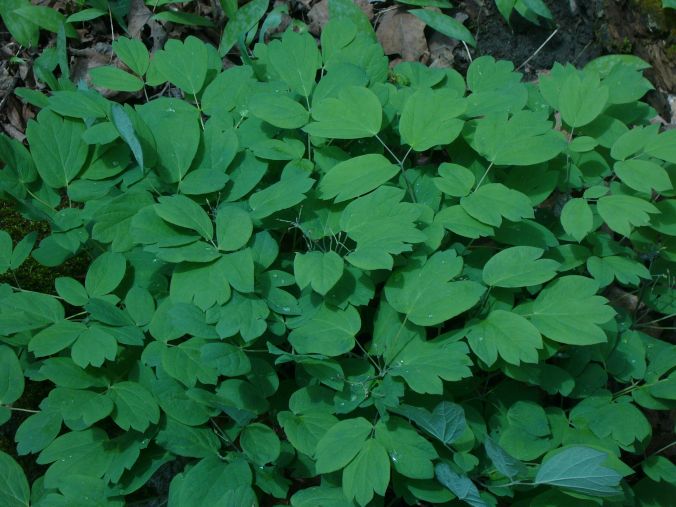Spring takes Her sweet time here in the North, and while I wait for the full bloom of summer, I always start gathering plants and making medicines that will serve us all well through the next year. First among these are vinegars. While oils for salve are generally next, right now the fresh young leaves and flowers of many plants are begging to be put up in vinegars. I love them all, and cannot wait till they’re ready for salad dressing, sprinkling on steamed vegetables, and making refreshing cool drinks. The dogs get a Tbsp in their water dish, and some – especially rose – I use diluted for sunburns and rashes, all too common around here I’m afraid.
Vinegars are a wonderful way for those new to herbs to explore the range of flavour, techniques of using, and medicinal uses of plants. While I make them all year round, there’s something so special about waiting for the first nettles and artemisias to reach just the right growth stage for harvesting, something magical about checking the garden every morning to see just how high the comfrey is… and the spruce buds! I stand by my beautiful white spruce, singing a love song to her magical nourishment and medicine while I gather, and I swear, the birds around us sing along. Later in the season, I’ll make plenty of rose, monarda, thyme, rosemary, sage and basil… and come winter, it’s time to start more white pine needle brewing (one of my very favorites) and the ever-changing but always useful Fire Cider (more on these to come).
The method of herbal vinegars is so easy, once you’ve made a few, as with elixirs, honeys and pastilles, you’re only limited by your imagination. Here then are a few of my standards – really it would be more accurate to say standards in The Repertoire, because everyone uses them! and the methods for putting them together. I’m putting this in Q&A form, to cover some of the questions I had when I started making these lovely herbal delights many years ago.
What kind of vinegar do I use – white, red or white wine, balsamic, apple cider, raspberry?
Apple Cider is the version most touted for health benefits, and many of it’s fans swear by it. Generally speaking that’s what I use too, as my herbal creations are designed to taste lovely and support health – but I’ve experimented with white and red wine, balsamic, raspberry and some of these funky/wonderful products too:http://www.wildfoods.ca/products-vinegars.html with, well, mixed results. Suffice to say I will not be without a couple of them for cooking – dressings and marinades but they haven’t always combined well with herbs, tastewise. For our purposes here, let’s stick with apple cider. I’ll share some other funky/delicious combinations in the months to come.
Here’s a brief rundown on what vinegars actually are:
“Vinegar is a product of fermentation. This is a process in which sugars in a food are broken down by bacteria and yeast. In the first stage of fermentation, the sugars are turned into alcohol. Then, if the alcohol ferments further, you get vinegar. The word comes from the French, meaning “sour wine.” While vinegar can be made from all sorts of things — like many fruits, vegetables, and grains — apple cider vinegar comes from pulverized apples.
The main ingredient of apple cider vinegar, or any vinegar, is acetic acid. However, vinegars also have other acids, vitamins, mineral salts, and amino acids.”
What are the health benefits of apple cider vinegar?
This is a question I’ve given some thought to; proponents of acv claim sometimes wild and unsubstantiated benefit, most often things like “in combination with a specific diet and herbs, acv worked wonders for my dog’s arthritis”…well, I’ve “worked wonders” with countless dogs myself, without acv – perhaps it was the diet and herbs? The scientist in me always wants to know. Those who claim great benefit from acv can also be confused about the ph-altering effect it has and what the numbers mean(when measuring urinary ph with a strip, higher = alkaline, lower = acidic, and we strive for a neutral middle area, usually 6 – 6.5.) ACV used alone has been touted as helping diabetes, heart disease, arthritis, poor appetite and obesity… and I’m not dismissive, but somewhat skeptical about thee claims. When you macerate HERBS into vinegar, however you most definitely extract some of the plant constituents into the vinegar – and thus they can be added to the diet as a tonic. Because tonics are used in small to moderate amounts over a period of time to build health in an organ, tissue, system – herbal vinegars can be a lovely means to add these herbs to your diet . For overt illness, acute or chronic, I prefer to use the more concentrated forms; tinctures, decoctions and infusions, elixirs.
What does “tonic” mean?
A tonic is the term used for herbs used over time in daily doses, to nourish the body, improve overall health or specifically target an organ or system. For example, hawthorn is a cardiovascular tonic, meaning we take it (I certainly do) in daily regular amounts, to tone and strengthen the heart and blood vessels. Many herbs can be taken in daily amounts as a tonic or in concentrated form when illness strikes. I drink a cup of elderberry tea almost every day, as an immune strengthener, but when I have a cold I take dropperfulls of the berry elixir throughout the first day. Adding vinegar to anyone’s diet – human or other animal – is a tonic approach, and we can choose herbs that fulfill the needs we perceive – nettles are important for allergies, dandelion and burdock support the liver, motherwort for the heart and nervous system, rose for digestion and anxiety, milky oats for exhaustion…daily, regular doses.
Which herbs can I use, and what are they good for? Should they be fresh or dried?
To be sure, you can use both. Many people feel a bit more comfortable with dried, and so might think about starting their medicine-making with dried burdock and dandelion root, two beneficial and flavourful varieties. If using dried herbs, please allow more time for them to macerate. I make a burdock root vinegar every fall and take it over the winter; I like to let it sit at least 6 weeks before using. Burdock is very cooling, but I offset the effect of this with spicy warming herbs like ginger and turmeric and clove, throughout the cold months. I often make coat conditioners for dogs using dried calendula, lavender, sage, yarrow and rose.
But I love to use the fresh plants of spring for these tonic vinegars; my own favorites are motherwort, violets, chickweed, dandelion leaf and flower, garlic chives, garlic mustard, mugwort – and later of course, all the bounty of summer – sage, monarda, thyme, hyssop, lemon balm, various mints, elderflower, rose and more. I recommend learning the medicinal properties of these plants if you aren’t already familiar with them – it’s a simple way to start learning the plants and adding some of their medicine to your own diet (or your dog’s!) in small, safe doses.
How do I make it?
First of all, if you’re using wild plants gathered around your area, a couple of all-important reminders. Rule Number One of all wildcrafting; be 100% sure you know your plants. Even Dandelion has a lookalike( Cat’s ear) and while most of the ones that look similar will not be poisonous, some could have adverse effects and we don’t want to risk that! I’m a huge believer in learning a little basic botany to help with identification; take that extra moment and make sure you have Artemisia vulgaris, Leonorus cardiaca, Stellaria media. Knowing the Latin names and the defining characteristics of your plants is not a dry academic exercise – it’s essential. When in doubt, don’t pick.
My pick of the beginner books for understanding basic botany: Thomas Elpel’s Botany in a Day.
http://www.hopspress.com/Books/Botany_in_a_Day.htm
And second, please harvest cautiously, never taking from anywhere that might have been sprayed, and not too close to roadsides or houses…I have a wonderful rosa rugosa growing out of a part of my carport that is lined with railway logs – these contain creosote and may contaminate my rose. So, I harvest only from the other bush that is well away from the blocks. You need to know the potential hazards of things like creosote, RoundUp, and pressure treated wood. Harvest wisely -and always with thanks to the plants. I leave a blessing every time, which is most often a small prayer. Let your own beliefs and intuition guide you in that regard, but be sure to thank them in some way.
Now; here’s what you need to get going. 🙂
Materials
a sterile glass jar, pint or quart depending on how much you plan to make
a plastic top or waxed paper
your plant, garbled and chopped
vinegar of choice
chopsticks
label and pen
After you have sterilized your bottle, place the chopped herb in to about the 2/3 level (lightly packed – too much makes a mess and too little is a weak medicine). Pour the vinegar – heated or not – overtop and use the chopstick to stir it in well.
Cover your plant well, and the use either a plastic lid, or wax paper with a standard ringtop lid. Vinegar should not come into contact with metal or it blackens and is most unappealling. I use wax paper or plastic wrap most of the time as a barrier, but have also found with my Bernardin lids, the plastic coating inside the lid liner prevents contact with metal. If using empty honey jars, though, I always line with something.
Then, just store in a cool dark cabinet or corner of your cupboard – check every day or so,, shake or stir -and six weeks later you have a beautiful, tasty and mineral rich medicine. If I’m using roots 0 burdock, yellowdock, dandelion, I might leave it sit two weeks more.
decanting pine needles in apple cider vinegar
Pasteurization?
This is a topic that seems to divide herbalists a little; some use pasteurized acv, others use unpasteurized and heat it, and some use unpasteurized as is without heating.I do both, but if I use unpasteurized acv without heating it, I make extra sure I shake, stir and check on my medicine daily. In reading countless forums and articles about this topic I have come to the conclusion that it’s entirely up to YOU. Susun Weed heats her unpasteurized vinegar because “Raw vinegar and herbs can combine to make strange (stinky) alien beasts” – with the greatest of respect for Susun, I have not found this to be so. Many of my herbalist friends feel raw acv is far more medicinal,and I’ve used it by far more then I’ve used either purchased pasteurized vinegar or heated my own. Most definitely if I’m using the end product externally I do not heat it. Susun does make the important point that if you do heat an unpasteurized product, do so in a non metallic pan.
How can I use them?
There are many ways to incorporate herbal vinegars into daily life. I often use them with olive or other oils and herbs to make salad dressings; you are only limited by imagination and taste preferences. You can always spoon a little over cooked veggies, stir into soups (especially nice with lentils) or just place your daily Tablespoon into a glass of water and drink it down (or sip with an ice cube on a hot summer day) . For my dogs, I put a little in their drinking water, and if they don’t like it, a little might get into their dinner – in which case they don’t seem to notice!
Let’s not forget the topical uses and value of acv, and especially herbal acv – Kiva Rose uses diluted rosepetal vinegar for sunburn and got me started using it this way too. In my house we have two bottles of rose vinegar every summer – one for skin only and occasionally, covering up the odour of cat urine. I rescue cats, and we have bouts of (occasional, thankfully) spraying. I have never found anything as helpful in eradicating the urine smell – or as deterrent to repeat offenses! as a good dousing with rose vinegar.
Many infused vinegars can be used as skin conditioners for dogs, especially after bathing, I like to dilute a mix of yarrow, chamomile, calendula and lavender into a liter of water and rinse well. I often pour a cup of herbal vinegar into my own bath to help with dry flaky skin or dullness. My partner experiences a lot of heat rash working outside in summer; I use diluted rose vinegar first and follow up with a dusting of arrowroot/mallow/ calendula powder.
The uses for herbal vinegar also include spraying countertops as a disinfectant, and your kitchen will smell lovely when you’re done (I especially love lemon thyme for this!)
But – more on all of this in later posts – here I am focused on Spring things – and before it is summer, I’d better get posted. Upcoming vinegar posts will talk more about health benefits of various plants; extraction of constituents in acetic acid (vinegar), use of different types of vinegar (rice, white and red wine,balsamic, maple, chokecherry and Canada plum) and bottling ideas. But right now, we have to get out and get harvesting!
After a glorious couple of weeks harvesting your dandies, violets, spruce tips, mugwort and so on; you end up with something like this; a cabinet filled with lovely-tasting vinegars that add to your health, culinary creativity and connection to the earth. Enjoy, experiment and share what you find. I will keep on sharing mine, as I go.
Resources
Susun Weed’s discussion forum and articles on vinegar
Kiva Rose’s blog http://www.bearmedicineherbals.com
Rosemary Gladstar, assorted writings





























